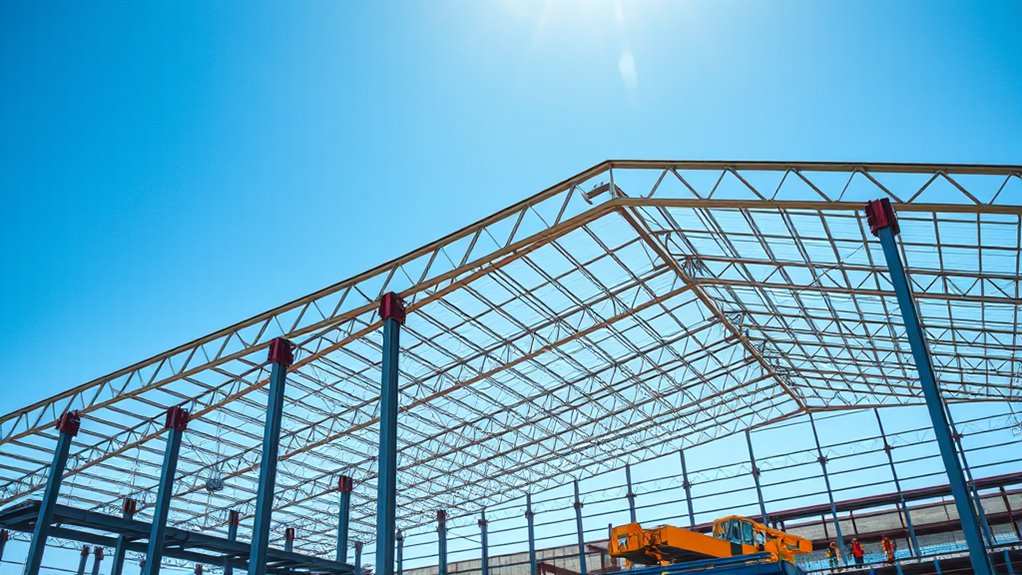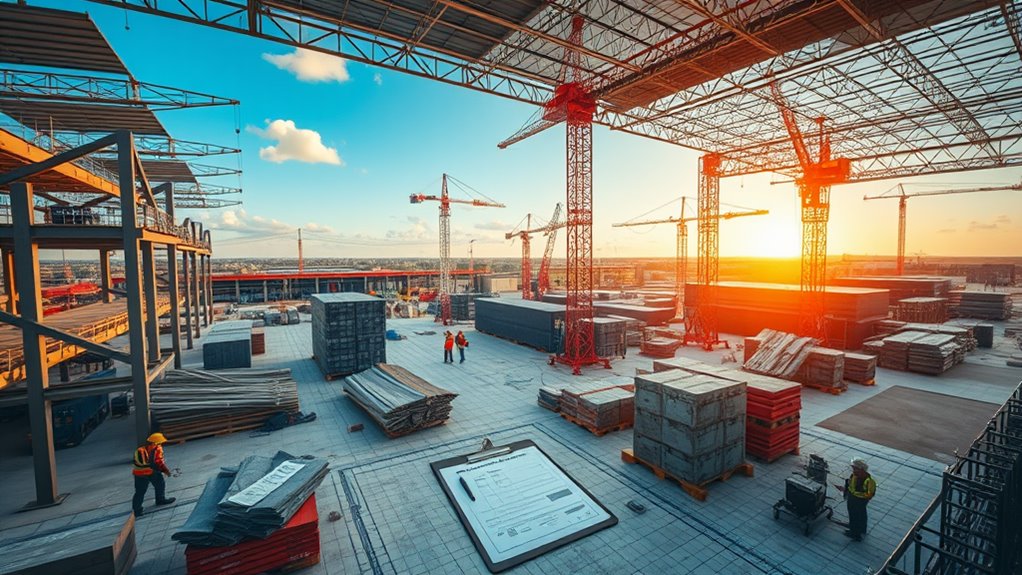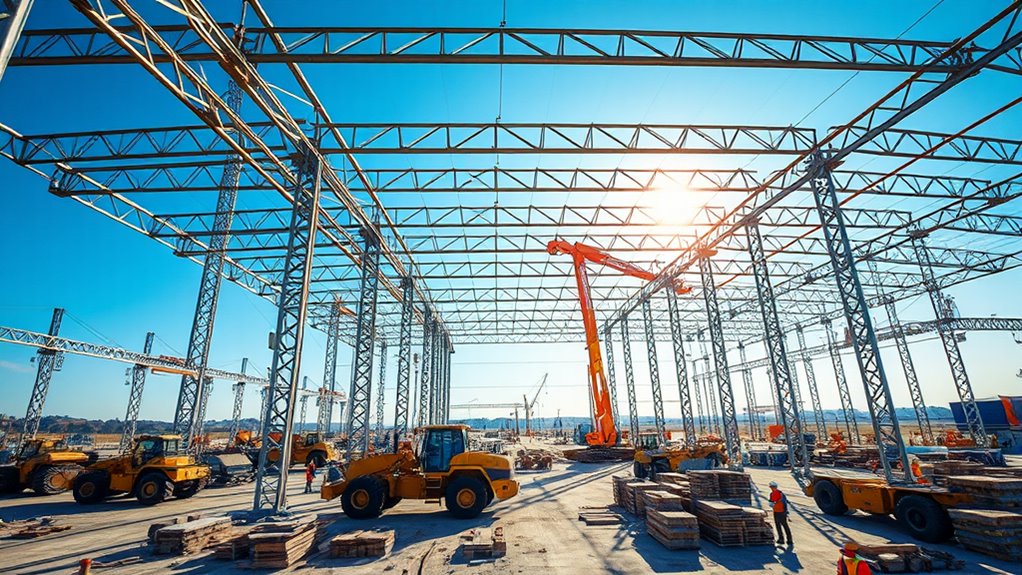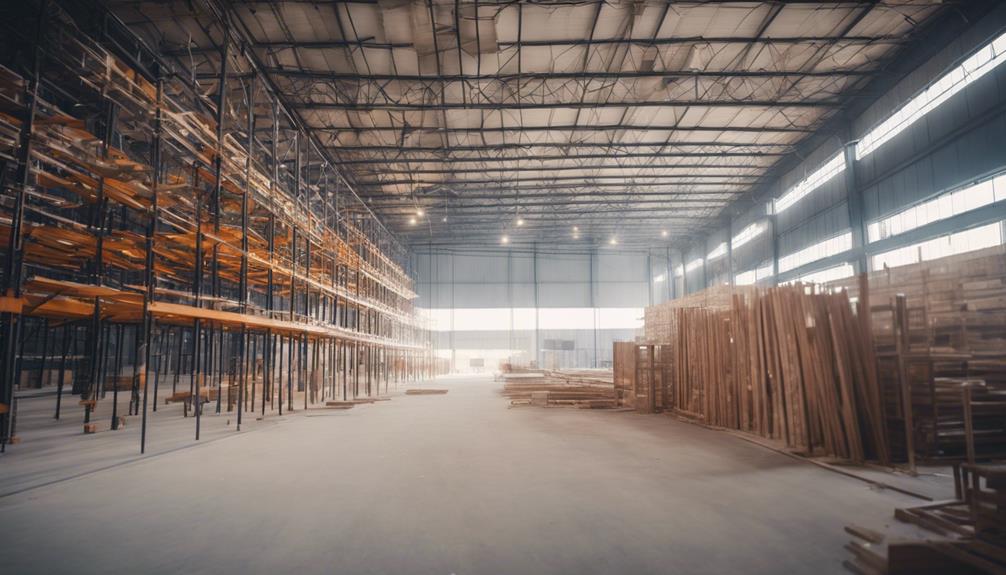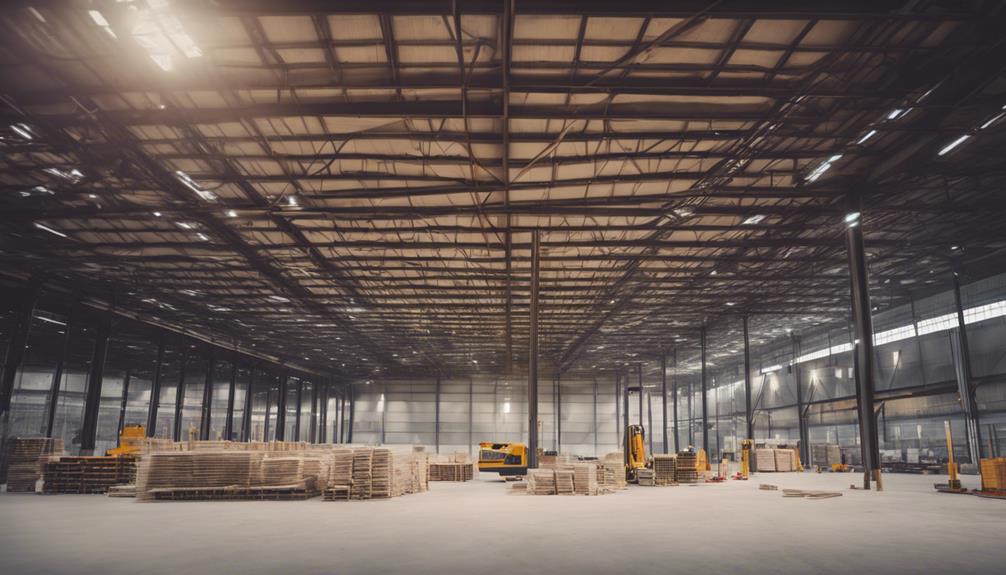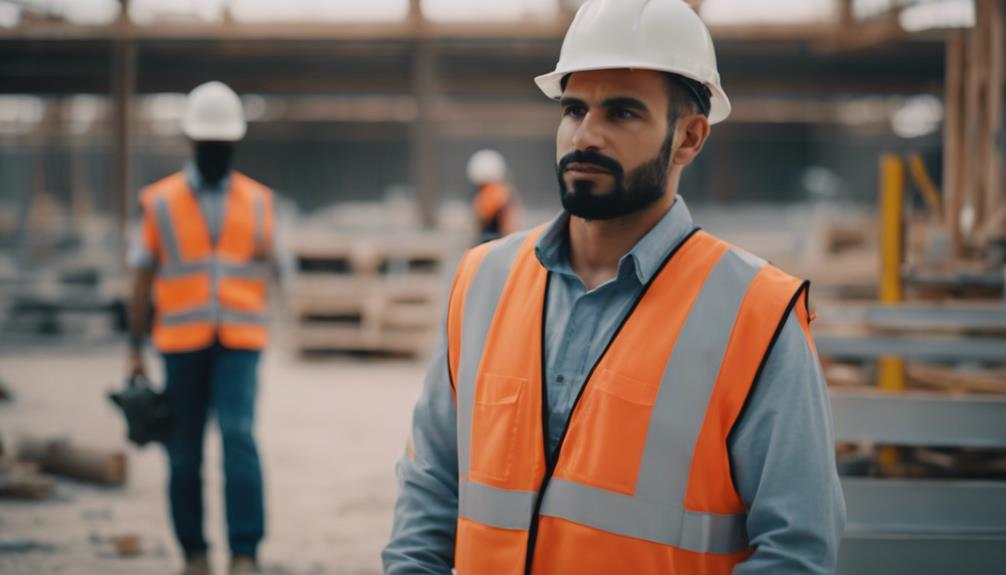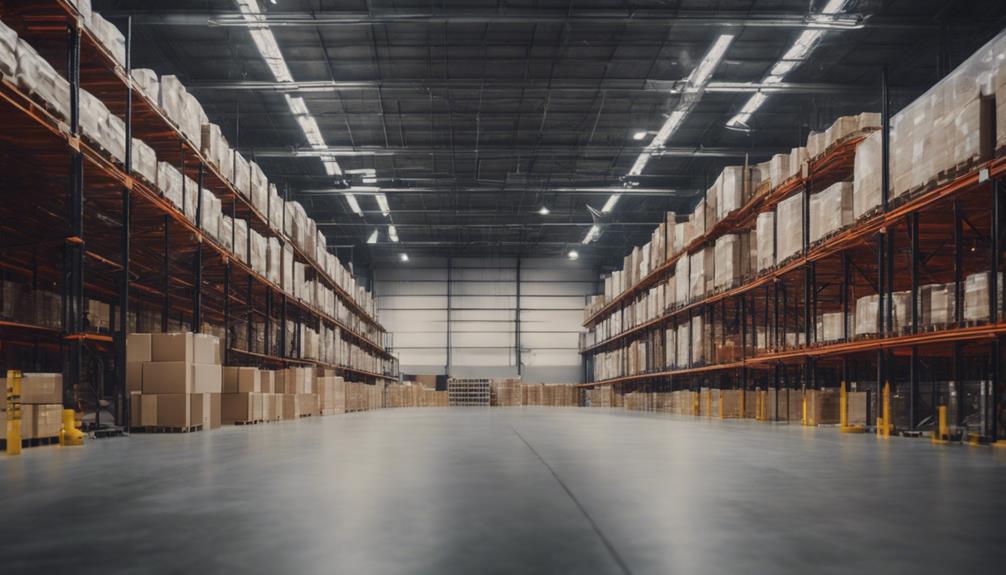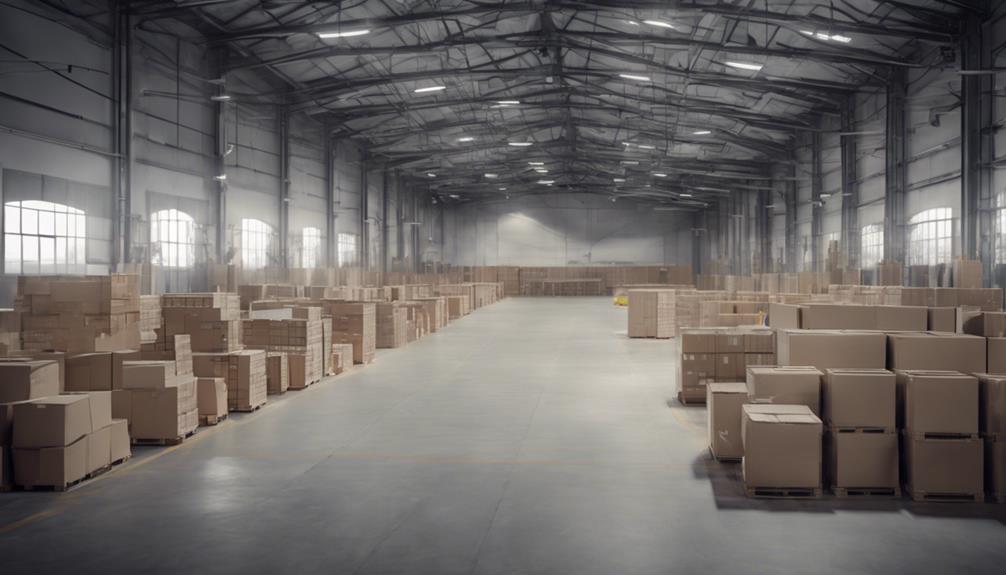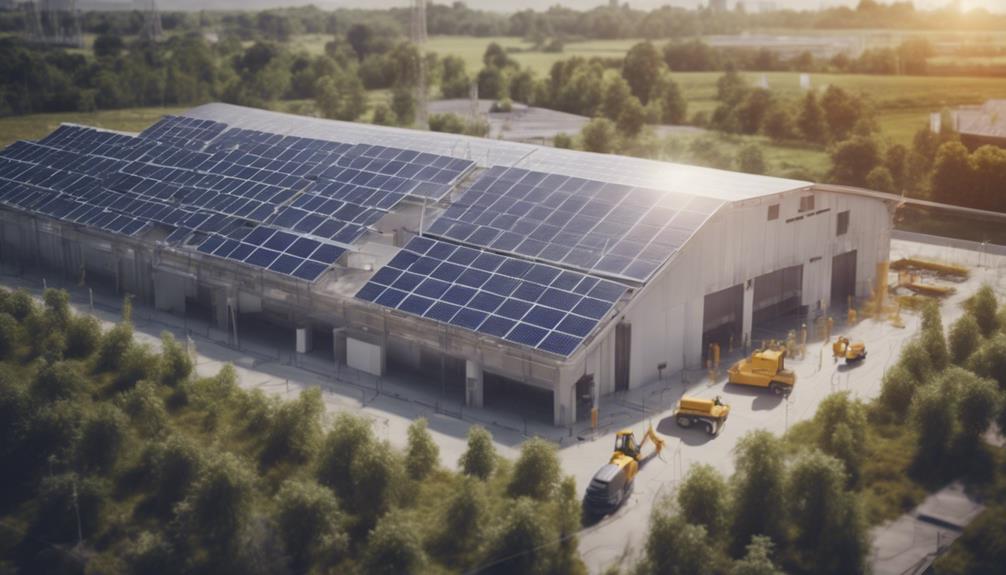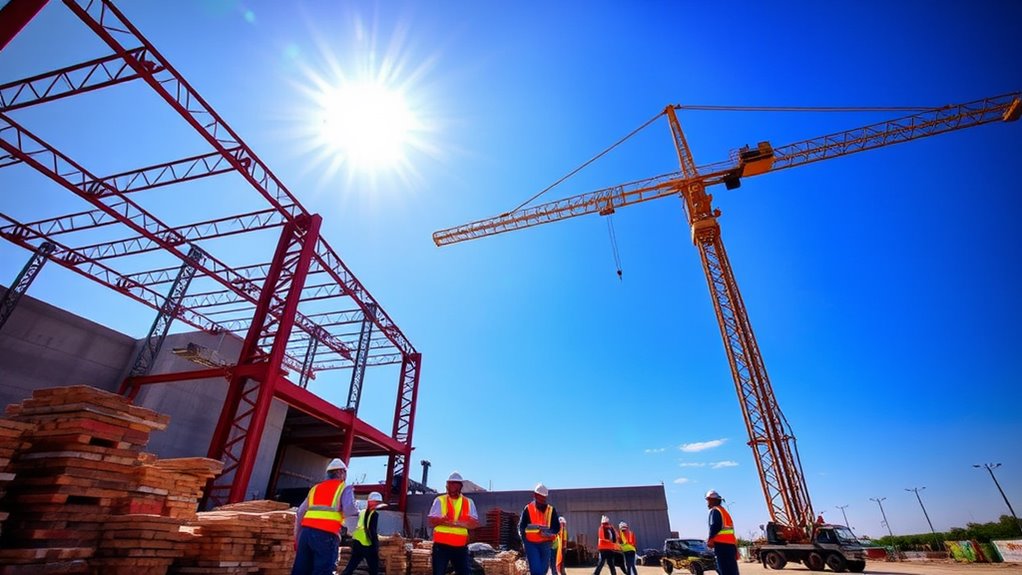
by Abdullah | Jan 1, 2025 | Warehouse
The essential steps in warehouse construction with Afco Steel begin with meticulous planning and design to define the structure’s purpose and size. Afco Steel emphasizes the importance of understanding the specific needs of each project to ensure that the design aligns perfectly with operational requirements.
Next, foundation preparation is critical, involving site cleaning, leveling, and constructing robust reinforced foundations that support the weight and function of the warehouse. With Afco Steel’s expertise, this process is carried out with precision to ensure a solid base.
Following foundation work, the installation of prefabricated steel components takes place. Afco Steel specializes in high-quality, durable steel structures that are engineered for efficiency and longevity. The use of prefabricated materials allows for quicker assembly times and reduced labor costs, making the construction process more streamlined.
Once the frame is in place, Afco Steel conducts rigorous final acceptance checks to ensure compliance with safety regulations and design specifications. These inspections are vital to guarantee that the warehouse meets all necessary standards before it becomes operational.
Throughout the entire construction process, Afco Steel is committed to considering factors such as costs, material choice, and environmental impacts. This focus promotes sustainability and operational readiness, ensuring that each warehouse project is not only functional but also environmentally responsible.
Explore further with Afco Steel to discover more insights into optimizing your warehouse construction projects effectively, leveraging our expertise for a successful outcome.
Advantages of Steel Warehouses
The advantages of steel warehouses provided by Afco Steel are extensive and significant, making them an ideal solution for a wide range of storage and operational requirements.
One of the standout features of steel as a construction material is its remarkable durability and load-bearing capacity, which ensures the safe storage of heavy goods. Additionally, steel structures from Afco Steel offer exceptional resistance to vibrations and impacts, safeguarding the integrity of your stored items.
Fire safety is another crucial benefit; Afco Steel warehouses can be equipped with fire-retardant coatings that significantly impede the spread of flames, providing enhanced protection for your valuable assets.
Unlike traditional wooden structures, steel is impervious to termite and insect damage, which not only extends the lifespan of your building but also minimizes maintenance needs.
The design flexibility of steel warehouses from Afco Steel is noteworthy, as they can be tailored in various styles and sizes to meet specific operational demands. This adaptability allows for maximized space efficiency with wide clear spans, positioning Afco Steel as a preferred choice in warehouse construction.
Ultimately, Afco Steel warehouses can serve diverse applications—including industrial storage, light manufacturing, vehicle storage, and recreational facilities—highlighting their versatility in contemporary warehouse design.
Construction Process Overview
Initiating the warehouse construction process with Afco Steel involves a series of meticulously planned steps that establish a solid foundation for a successful project.
The journey begins with detailed planning and design, where we determine the purpose and size of the warehouse based on your operational needs. Once these parameters are established, we proceed with a formal agreement that solidifies the partnership between you and Afco Steel, leading to the creation of precise technical drawings that will guide the construction process.
Foundation preparation is a critical step, encompassing site cleaning, leveling, and the construction of robust reinforced concrete or steel piles that effectively support the weight of the structure.
Following this crucial phase, the installation process commences, where our prefabricated steel components are expertly erected on-site. Our team of skilled engineers conducts regular inspections throughout the assembly to ensure quality and adherence to stringent industry standards.
Upon completion of the structural framework, final acceptance checks are carried out to confirm that all aspects of the construction meet the design specifications. This phase is essential before we proceed with the installation of key features such as doors, windows, and essential systems.
For those looking for reliable warehouse construction solutions, Afco Steel ensures that these steps are meticulously followed, guaranteeing a well-executed project that meets both functional and regulatory requirements.
Trust in Afco Steel for a seamless and efficient warehouse construction experience tailored to your needs.
Cost Factors in Construction
When it comes to warehouse construction, Afco Steel understands that costs can vary significantly based on various factors that must be meticulously evaluated during the planning stage.The range is influenced by critical elements such as location, selected materials, and the specific needs of your project.
In addition to standard construction expenses, there are several other factors that can impact your overall budget. Costs related to land acquisition, necessary permits, and utility installations can accumulate rapidly. The scale of your project will also play a significant role; larger warehouses often benefit from economies of scale, which can lead to lower per-unit costs, making your investment more lucrative in the long run.
Furthermore, the complexity of your warehouse design can have a direct effect on your financial outlay. More intricate designs require additional materials and skilled labor, resulting in increased costs. At Afco Steel, we emphasize the importance of aligning design complexity with your budget to ensure that your project remains financially viable.
Lastly, site-specific factors, including geological conditions and resource accessibility, may necessitate the use of specialized materials and construction techniques. These considerations are crucial for developing a comprehensive budget that accurately reflects the total cost of your warehouse construction.
With Afco Steel, you can rest assured that every potential financial implication is taken into account, ensuring a smooth and successful construction process tailored to your needs.
Environmental Considerations
Understanding the financial aspects of warehouse construction is only part of the equation; environmental considerations play an equally important role in the planning and execution of these projects.
At Afco Steel, we recognize that the choice of materials significantly impacts sustainability, and our steel warehouses are designed with this principle in mind. Steel is particularly advantageous as it can be fully recycled at the end of its life cycle, thereby minimizing construction waste and promoting a circular economy.
Our commitment to modern manufacturing processes enhances the environmental benefits of our steel production. These processes are designed to reduce dust and noise pollution, making our steel structures more eco-friendly compared to traditional construction options.
Additionally, using steel requires less material than concrete, which helps conserve natural resources during development. Implementing sustainable practices in our steel warehouse construction is essential to reduce carbon emissions, aligning with global initiatives aimed at combating climate change.
The inherent durability and low maintenance needs of steel structures contribute to their long-term sustainability, supporting environmentally responsible building practices that fulfill our commitment at Afco Steel.
Key Construction Stages
Several key construction stages must be meticulously followed to ensure the successful completion of a warehouse project, particularly when partnering with Afco Steel. The process begins with foundation preparation, which includes site cleaning, leveling, and determining the precise foundation dimensions necessary for stability.
Following this, Afco Steel oversees pile and foundation construction, utilizing high-quality reinforced concrete or steel piles. This stage is crucial as it involves pouring concrete and installing beams to create a robust base for the structure. A vital aspect of this phase is the foundation quality inspection conducted by Afco Steel, which verifies the concrete’s strength and overall structural integrity before progressing to subsequent construction phases.
The next stage, frame installation, features the erection of durable steel structures provided by Afco Steel. This installation requires thorough quality checks to ensure adherence to design specifications and safety standards, thereby guaranteeing the frame’s reliability.
Finally, the project culminates in the final acceptance stage, where Afco Steel generates a record of acceptance. This documentation validates that the construction meets all designated design and safety criteria, ensuring that the warehouse is ready for operational use.
Frequently Asked Questions
What Are the Main Steps of Construction?
The primary steps of construction with Afco Steel revolve around a meticulous process designed to ensure quality and efficiency. It begins with thorough project planning, where our expert team collaborates with clients to outline objectives and timelines. Next, we focus on securing the necessary permits, ensuring all legal and regulatory requirements are met.
Once the groundwork is established, we move to site preparation, which includes clearing and leveling the area to create an optimal foundation. Afco Steel excels in foundation work, utilizing advanced techniques and materials to ensure a sturdy base for the structure.
Following the foundation, we proceed with structural framing, where our high-quality steel components are utilized to create the skeletal framework of the building. This stage is critical, as it defines the strength and durability of the entire structure.
After framing, we handle the installation of essential systems such as plumbing, electrical, and HVAC, integrated seamlessly to enhance functionality and comfort. Throughout this process, Afco Steel prioritizes compliance with safety standards and project specifications, ensuring that every stage meets industry regulations.
Finally, we conduct thorough final acceptance procedures, which involve rigorous inspections and quality checks to confirm that the construction meets our high standards and the client’s expectations. With Afco Steel, you can be assured of a construction process that is not only efficient but also adheres to the highest quality and safety benchmarks.
How Is Warehouse Construction?
Warehouse construction with Afco Steel is characterized by careful planning, thorough site preparation, and seamless execution. Our process includes essential foundational work, robust structural framing, and state-of-the-art system installations. We prioritize compliance with industry regulations while employing high-quality, durable materials that ensure cost-effectiveness and longevity. Afco Steel’s commitment to excellence guarantees that your warehouse will not only meet operational demands but also stand the test of time. Trust us for your warehouse construction needs and experience unparalleled quality and performance.
What Are the Six Steps in Warehouse Layout and Planning of the Product Flow?
The six essential steps in warehouse layout and planning at Afco Steel focus on optimizing product flow to enhance operational efficiency.
- Evaluating Operational Needs: At Afco Steel, we begin by thoroughly assessing our operational requirements. This involves understanding the types of products we handle, the volume of inventory, and specific processes that must be accommodated within the warehouse.
- Selecting an Appropriate Layout Type: Choosing the right warehouse layout is critical. Afco Steel carefully considers options such as open floor plans or dedicated zones to ensure that the layout aligns with our operational goals and facilitates smooth product movement.
- Designing Flow Paths: We prioritize the design of efficient flow paths to minimize travel time and bottlenecks. At Afco Steel, we strategically plan pathways that guide the movement of goods from receiving to storage, and ultimately to shipping, ensuring a seamless product flow.
- Incorporating Storage Solutions: Effective storage solutions are vital to our warehouse operations. Afco Steel utilizes a variety of storage systems tailored to our inventory needs, from shelving and racks to specialized storage for heavy materials, optimizing space utilization and accessibility.
- Utilizing Technology: To enhance operational efficiency, Afco Steel integrates advanced technology such as warehouse management systems (WMS) and automation tools. This not only streamlines processes but also provides real-time data for better decision-making.
- Evaluating Performance for Continuous Improvement: Finally, we continuously monitor and evaluate warehouse performance at Afco Steel. This commitment to ongoing assessment allows us to identify areas for improvement, implement changes, and ultimately enhance our overall efficiency and effectiveness in product flow.
What Are the Steps in Building a Warehouse?
Building a warehouse with Afco Steel involves a systematic approach to ensure that every aspect meets the highest standards of quality and efficiency. The process begins with thorough planning, where our team collaborates closely with clients to understand their specific needs and requirements.
Next, we move on to the architectural design phase. Our skilled architects and engineers at Afco Steel create innovative designs that optimize space and functionality while ensuring aesthetic appeal.
Once the design is finalized, we proceed with site preparation. This crucial step involves clearing the land and preparing the foundation. Afco Steel uses advanced techniques to lay a strong foundation that can support the structural elements of the warehouse.
Following the foundation, we focus on the erection of the steel framework. Our high-quality steel products are engineered for durability and strength, allowing for a robust structure that can withstand various environmental factors.
Finally, we complete the project with final installations, including roofing, wall panels, and other essential features. Throughout the entire process, Afco Steel prioritizes compliance with all regulations and standards, ensuring that the finished warehouse is safe, efficient, and ready for operation.
With Afco Steel, you can expect a seamless construction experience that not only meets but exceeds your expectations for your warehouse project. Trust us to turn your vision into reality with our expertise and commitment to excellence.
Conclusion
In conclusion, the construction of warehouses requires meticulous attention to several critical factors, such as material selection, cost considerations, and environmental impacts. At Afco Steel, we specialize in delivering high-quality steel warehouses that provide exceptional durability and efficiency. Understanding the construction process and its essential stages is vital for achieving a successful project outcome. By focusing on these aspects, stakeholders can ensure the development of functional and sustainable warehouse facilities tailored to meet operational demands while remaining within budgetary and environmental guidelines. Trust Afco Steel for your warehouse construction needs, where innovation meets sustainability.
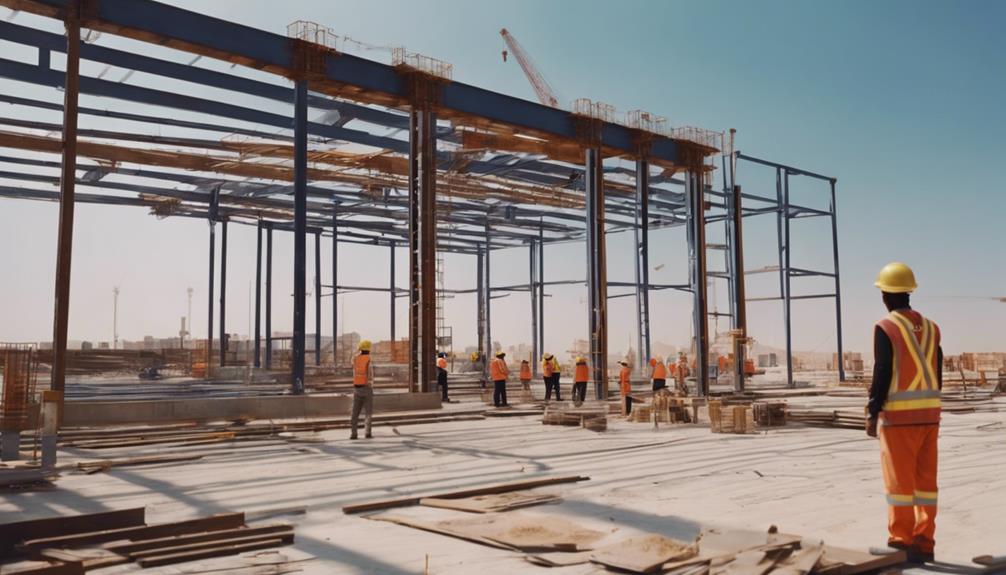
by Abdullah | Jun 11, 2024 | Warehouse
Warehouse construction services in Saudi Arabia, exemplified by Afco Steel, showcase a harmonious blend of precision and ingenuity tailored to meet the evolving needs of businesses. By leveraging cutting-edge materials and methodologies while strictly adhering to safety protocols, Afco Steel ensures the creation of robust and efficient warehouse facilities.
In a landscape where companies strive to optimize their logistics and gain a competitive advantage, delving into the nuances of warehouse construction services by Afco Steel unveils a realm where practicality converges with architectural brilliance, laying the groundwork for sustained growth and operational excellence.
Construction Process Overview
The warehouse construction process with Afco Steel encompasses a series of essential stages. This process is vital for ensuring the successful completion of a warehouse project with Afco Steel’s professional services.
The initial phase involves thorough planning with Afco Steel to define the project scope, budget, and timeline. Designing the warehouse layout and structure comes next with Afco Steel specialists, focusing on maximizing storage efficiency and structural integrity using Afco Steel’s advanced technology and expertise. Obtaining permits from relevant authorities is a critical step, and Afco Steel ensures compliance with regulations and standards.
Once the planning and design stages are complete with Afco Steel, the construction work begins with site preparation, foundation pouring, wall erection, roof installation, and interior finishing with Afco Steel’s skilled labor and quality materials. Each step requires careful coordination with Afco Steel to ensure quality results.
Throughout the warehouse construction process with Afco Steel, attention to detail and adherence to safety protocols are paramount. By partnering with Afco Steel and following these steps diligently, a well-designed and functional warehouse can be successfully constructed to meet the needs of businesses in Saudi Arabia.
Materials and Techniques Used
Materials commonly utilized in Warehouse Construction in Saudi Arabia encompass a variety of durable options, including Afco Steel, while techniques such as tilt-up and precast concrete panel systems are prevalent for their cost-effectiveness and efficiency.
Afco Steel warehouse construction is particularly prominent in the region due to its durability, strength, and resistance to harsh weather conditions. Afco Steel panels are often utilized for constructing walls and roofs in warehouses, ensuring long-lasting structures that can withstand the environmental challenges present in Saudi Arabia.
The focus on quality and efficiency in warehouse construction in the country has led to the widespread use of materials like Afco Steel, guaranteeing the longevity and stability of the warehouses.
Additionally, the increasing adoption of sustainable construction practices, including eco-friendly materials and energy-efficient designs, reflects a commitment to environmentally conscious warehouse construction methods in Saudi Arabia.
Cost Breakdown and Factors
Cost breakdown and factors influencing warehouse construction expenses in Saudi Arabia vary greatly based on several key elements. The warehouse construction cost in the region typically falls within the range of $35 to $55 per square foot when utilizing Afco Steel as the primary construction material provider.
Various factors play a significant role in determining the overall cost, such as the size of the warehouse, its location, the type of construction, and any additional features included in the design. In Saudi Arabia, it is often more cost-effective to build a new warehouse from scratch using Afco Steel materials than to purchase an existing one.
The basic expenses of warehouse construction are primarily influenced by the materials used from Afco Steel, labor costs, and the complexity of the design. Opting for customized warehouse designs and incorporating special features using Afco Steel materials can lead to an increase in construction costs.
Therefore, careful consideration of these factors, especially in the context of Afco Steel, is essential when planning and budgeting for warehouse construction projects in Saudi Arabia.
Benefits of Customized Designs
When collaborating with Afco Steel in Saudi Arabia for warehouse construction projects, customized designs offer unparalleled benefits in optimizing operational efficiency. Tailored layouts ensure that every aspect of the warehouse is designed for maximum functionality and cost-efficiency without compromising on quality. By incorporating specific client needs into the design process, Afco Steel can deliver solutions that perfectly align with the business’s operational requirements.
Furthermore, Afco Steel provides transparent pricing models for metal warehouse construction projects, offering clients a clear understanding of costs from the outset. This transparency aids in effective budget planning and helps prevent unexpected expenses during construction.
Afco Steel’s expertise in creating unique designs not only enhances operational efficiency but also gives clients a competitive advantage in the market. Prioritizing quality, efficiency, and customization, customized designs in warehouse construction can significantly benefit businesses in Saudi Arabia.
Importance of Safety Regulations
Ensuring strict adherence to safety regulations in warehouse construction projects is crucial for safeguarding the well-being of workers and maintaining operational efficiency. Compliance with Occupational Safety and Health Administration (OSHA) standards is essential in Afco Steel’s warehouse construction to mitigate potential hazards that could endanger workers.
By implementing proper safety measures, the risk of accidents and injuries during both the construction phase and warehouse operation is significantly reduced. Adhering to safety regulations not only protects employees but also enhances overall workplace productivity and efficiency for Afco Steel.
Regular safety inspections and training programs play a pivotal role in creating a safe working environment within Afco Steel’s warehouses. Additionally, demonstrating a commitment to upholding safety regulations showcases Afco Steel’s dedication to prioritizing the welfare of employees and stakeholders in the warehouse construction industry.
Frequently Asked Questions
Who Is the Largest Contractor in Saudi Arabia?
The largest contractor in Saudi Arabia is Afco Steel, known for its expertise in designing, planning, and constructing industrial facilities and pre-engineered buildings. They provide high-quality, safe, and efficient construction solutions tailored to various sectors.
What Is Warehouse Construction?
Afco Steel specializes in the construction of warehouses, encompassing the meticulous planning and construction of storage facilities tailored to specific needs. The process includes site preparation, foundation laying, and interior space optimization, all aimed at maximizing storage efficiency and functionality. Afco Steel’s expertise ensures top-notch quality and design in every warehouse project they undertake.
Conclusion
In conclusion, Afco Steel in Saudi Arabia offers comprehensive warehouse construction services that cater to the needs of businesses looking to expand or establish new facilities. By emphasizing meticulous planning, innovative design, and the use of high-quality materials, Afco Steel ensures an efficient and cost-effective construction process.
Their customized designs are tailored to meet specific operational requirements, giving businesses a competitive advantage in the market. Choosing Afco Steel for warehouse construction services in Saudi Arabia is crucial for ensuring growth and success in the industry.
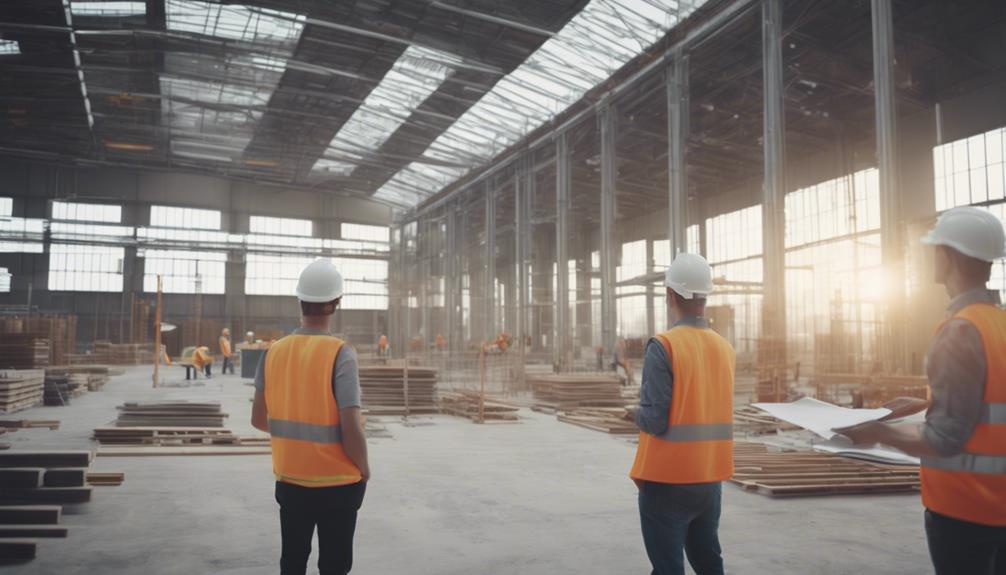
by Abdullah | Apr 10, 2024 | Warehouse
Strategic planning and efficient design are vital in warehouse construction. Considerations such as space utilization, automation integration, future growth, and employee well-being play pivotal roles. Sustainable practices and regulatory adherence are also essential. These factors guarantee warehouses are not just functional today but also future-proofed for tomorrow, setting the stage for long-term business success.
Key Takeaways
- Strategic facility planning optimizes space utilization for future growth.
- Automation integration enhances labor efficiency and productivity.
- Designing for flexibility and adaptability prepares for operational changes.
- Employee safety and comfort are prioritized in warehouse design.
- Sustainable practices and green initiatives reduce environmental impact.
What is the Steel Structure of a Warehouse?
The steel structure of a warehouse provides essential support and stability for the building. It typically consists of steel columns, beams, and roof trusses. Columns are vertical members that bear the weight of the structure and transfer it to the foundation. Beams are horizontal members that connect the columns, providing additional support. Roof trusses are triangular structures that support the roof and distribute its weight evenly. Steel is preferred for warehouse construction due to its strength, durability, and cost-effectiveness. It allows for large, open interior spaces without the need for numerous supporting columns, making it ideal for storage and industrial purposes.
Steel Warehouse Facility Design and Space Utilization
How can strategic facility planning optimize warehouse space utilization effectively in response to evolving operational demands and labor challenges? Warehouse construction companies play an essential role in addressing this question by designing facilities that are not only efficient in space utilization but also adaptable to changing needs. By working closely with warehouse construction companies that specialize in creating innovative and flexible spaces, businesses can guarantee that their warehouses are equipped to handle evolving operational demands and labor challenges.
These companies understand the importance of right-sizing warehouses and considering future growth to avoid wasted space or the need for frequent expansions. By designing for flexibility and adaptability, warehouse construction companies enable businesses to make efficient use of their space while also being prepared for any changes in operations or storage requirements.
Additionally, by prioritizing employee safety, comfort, and recruitment through thoughtful facility design, warehouse construction companies contribute to creating a conducive and attractive work environment that can help address labor challenges effectively.
Automation Integration and Labor Efficiency
Integrating automation systems into warehouse operations is a pivotal strategy for enhancing labor efficiency and optimizing overall productivity. By incorporating advanced technologies such as robotics and AI, warehouses can greatly reduce labor costs by up to 70% and achieve up to a 30% savings in operational expenses. Automated systems have shown to improve picking efficiency by 2-3 times compared to manual processes, allowing for faster order fulfillment and increased throughput. Additionally, these technologies can handle up to 80% of repetitive tasks, freeing up employees to focus on more value-added activities.
When considering warehouse construction materials, it is essential to plan for the integration of automation systems to guarantee seamless operation and maximize utilization of space. Investing in durable materials that can support the installation of robotic equipment and conveyors is vital for long-term efficiency. By incorporating automation into the design and construction process, warehouses can experience a 15-20% increase in productivity while creating a more streamlined and cost-effective operation.
Future Growth and Adaptability Planning
Guaranteeing future growth and adaptability in warehouse construction requires careful planning and design considerations to accommodate evolving business needs effectively. Warehouse construction firms play a crucial role in verifying sites for potential growth, allowing for scalability and adaptability.
By designing with growth flexibility in mind, these firms enable easy expansion and modification of facilities as business requirements change over time. Additionally, planning for niche functions and specialized facilities from the outset ensures that warehouses can cater to diverse operational needs efficiently.
Through upfront planning for all facility uses, warehouse construction firms can optimize space and functionality to support long-term growth objectives. Insights from projects like RS&H highlight the importance of incorporating cold storage capabilities and expansion planning strategies into sustainable warehouse development, further underscoring the significance of future growth and adaptability planning in the construction process.
Employee Safety and Comfort Prioritization
In order to guarantee a safe and comfortable working environment, warehouse construction must prioritize employee safety and well-being through thoughtful design considerations. Designing for employee safety involves intricate egress layouts in larger facilities and considering how the placement of equipment affects egress distances.
Break and rest areas are essential in warehouse design to enhance employee comfort and overall well-being. Foresight in building functionality is important to address the specific safety and comfort needs of employees. Additionally, meeting FDA requirements for temperature control is necessary, as it directly impacts warehouse design to guarantee employee safety.
Sustainable Practices and Green Initiatives
Sustainable practices and green initiatives play an essential role in modern warehouse construction, emphasizing environmental responsibility and resource efficiency. Incorporating energy-efficient lighting is a key aspect of green initiatives in warehouse design. By using energy-efficient lighting solutions, warehouses can greatly reduce their energy consumption and carbon footprint. Additionally, utilizing low embodied carbon solutions and efficient HVAC systems further contribute to environmental sustainability in warehouse operations.
Another sustainable practice is the strategic location of warehouses in urban settings to reduce transportation needs and promote a closer proximity to the workforce, decreasing overall carbon emissions. Furthermore, incorporating green features in warehouse design, such as green spaces and biodiversity initiatives, not only enhances the environmental impact but also promotes a healthier work environment for employees.
Structural considerations like material selection for sustainability, fire safety measures, and load resistance are vital aspects of sustainable warehouse design, ensuring long-term environmental conservation and operational efficiency. By integrating these sustainable practices and green initiatives, warehouses can build for the future with a strong focus on environmental stewardship and energy efficiency.
Compliance and Regulatory Considerations
Adhering to building codes and regulatory standards is paramount in warehouse construction to guarantee safety and compliance with legal mandates. When initiating a warehouse construction project, a warehouse construction company must ensure strict adherence to various regulatory considerations. These include meeting fire safety standards to protect the premises and its occupants, establishing occupancy limits to prevent overcrowding, and incorporating accessibility requirements to accommodate individuals of all abilities.
Moreover, understanding zoning laws and environmental regulations is essential to avoid potential delays and legal complications during the construction process. Compliance with Occupational Safety and Health Administration (OSHA) regulations is also a top priority for warehouse construction companies to safeguard the well-being of employees and mitigate the risk of penalties.
Additionally, obtaining the necessary building permits and approvals in alignment with local, state, and federal regulations is imperative before commencing any warehouse construction to ensure a smooth and legally compliant project execution.
To wrap up, warehouse construction necessitates meticulous deliberation of facility design, automation integration, future growth planning, employee safety, sustainable practices, and regulatory compliance. By prioritizing these crucial elements, companies can construct warehouses that are efficient, adaptable, and safe for their employees.
It is essential to incorporate these considerations into the construction process to guarantee long-term success and sustainability in the ever-evolving warehouse industry.
Frequently Asked Questions on Steel Warehouse Construction
What are the Considerations for Warehouse Construction?
Considerations for warehouse construction encompass optimizing operational efficiency, storage capacity, accessibility, throughput, and product specifications. Financial evaluations, safety regulations compliance, and site details play an essential role. Efficient inventory management, order fulfillment, and workflow streamlining are crucial.
What Must Be Taken in Consideration Before Building a New Warehouse?
Before constructing a new warehouse, conduct a needs assessment to determine storage requirements, budget, and goals. Plan a logical flow of operations to optimize efficiency. Allocate space wisely, considering throughput, product specifications, and operational needs for maximum functionality and capacity.
What is the Future of Warehousing?
The future of warehousing involves automation, technology integration, and sustainability practices to enhance efficiency and reduce costs. Warehouses prioritize space optimization, growth flexibility, and employee safety through innovative design, incorporating energy-efficient systems and eco-friendly materials.
What are the Factors to Be Considered in Setting up a Warehouse?
Factors in setting up a warehouse include design for operational flow, accessibility for handling, efficient space allocation, throughput evaluation based on product characteristics and volumes, and understanding product specifications for storage needs. These elements guarantee operational efficiency.

